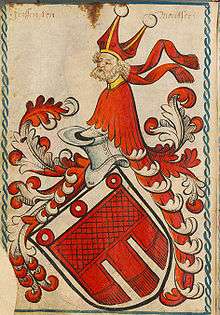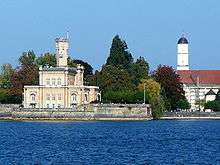Counts of Montfort

The Counts of Montfort were a German noble dynasty from Swabia. The influential and wealthy Counts of Montfort took their name from an ancestral castle named Montfort, which was situated close to today's Swiss border near Götzis, in the present-day Austrian state of Vorarlberg.
History

The counts held the lordships of Feldkirch (until 1390), Bregenz (until 1523) and Tettnang (until 1779). They had territories in Upper Swabia and particularly in Vorarlberg, most of which they ruled. Until the 18th century, the counts were a remarkable family of the high nobility, the most important in the region of Lake Constance, but the line eventually became extinct. In a number of places, including Feldkirch, Bregenz and Langenargen, there are still signs of their history.
The Montfort counts derive from rulers of the Swabian counts palatine (Pfalzgrafen) of Tübingen. Hugo of Tübingen (died 1182) had married the last heiress of the Counts of Bregenz, named Elisabeth. Around 1200, their son Hugo called himself a "Count of Montfort". The dynasty had Bregenz and later Tettnang as the main seat. The Minnesinger Hugo von Montfort (1357–1423) was a count of the Bregenz branch.
Around 1779, Tettnang was sold to the Austrian House of Habsburg in order to pay debts. Several years later, the line became extinct upon the death of Count Anton IV in 1787. The Habsburgs added the Montfort lands to their Further Austrian possessions.
Prince of Montfort
.svg.png)
In 1810, the Tettnang territory was adjudicated to the Kingdom of Württemberg. In 1816, King Frederick I vested his daughter Catharina and her husband Jérôme Bonaparte with the titles of Princess and Prince of Montfort (French: prince de Montfort).[1] This princely title continued in the family by descent.[2]
See also
Sources
- Karl Heinz Burmeister: Montfort, von (Grafen von Montfort), Familienartikel in: Neue Deutsche Biographie, Bd. 18, S. 51-54
- Karl Heinz Burmeister: Die Grafen von Montfort. Geschichte, Recht, Kultur. Festgabe zum 60. Geburtstag, hrsg. von Alois Niederstätter (= Forschungen zur Geschichte Vorarlbergs; NF 2). Universitätsverlag Konstanz, Konstanz 1996, ISBN 3-87940-560-3
- Karl Heinz Burmeister, Elmar L. Kuhn, Eva Moser u.a.: Die Grafen von Montfort. Geschichte und Kultur. (= Kunst am See; Band 8). Gessler, Friedrichshafen 1982, ISBN 3-922137-16-4
References
- ↑ Antoine-Vincent Arnault; Antoine Jay; Étienne de Jouy; Jacques Marquet de Norvins (1821). Biographie nouvelle des contemporains (in French). Paris: Librairie historique. p. 239.
- ↑ Gentleman's Magazine and Historical Review. London: Henry & Parker. 1860. p. 208.
External links
-
 Media related to Montfort family (Swabia) at Wikimedia Commons
Media related to Montfort family (Swabia) at Wikimedia Commons - Genealogy of the counts of Montfort